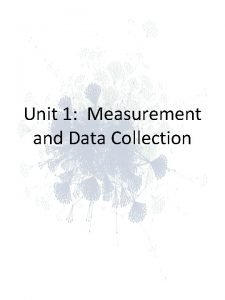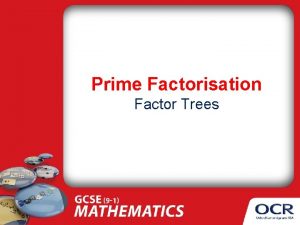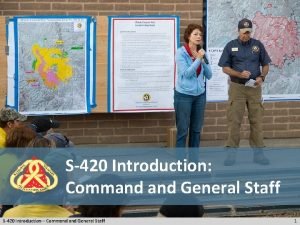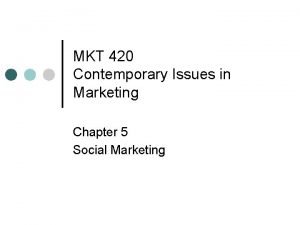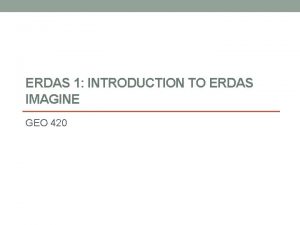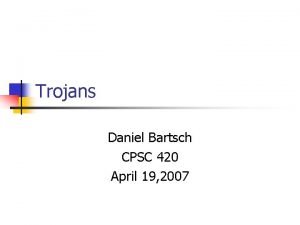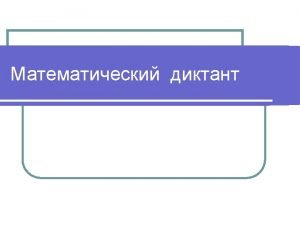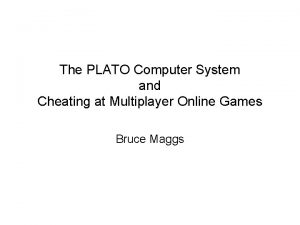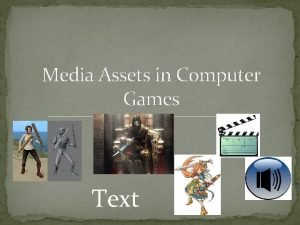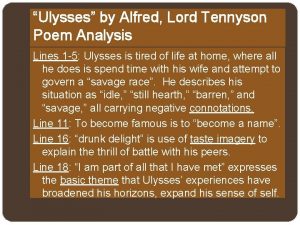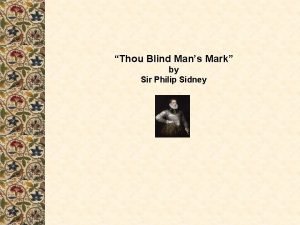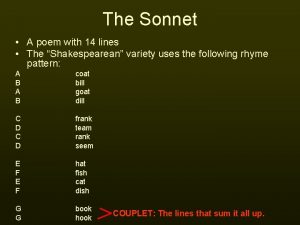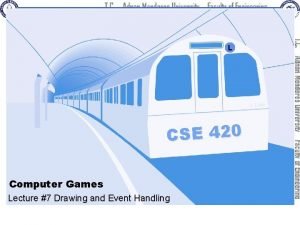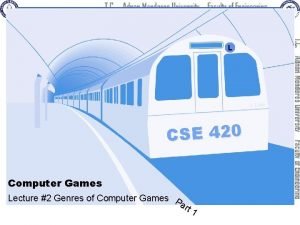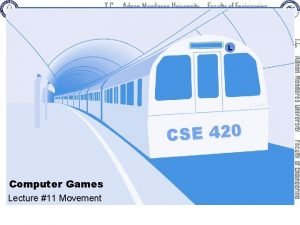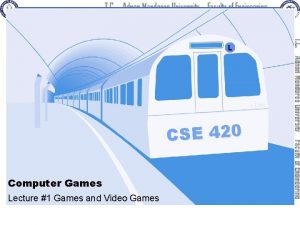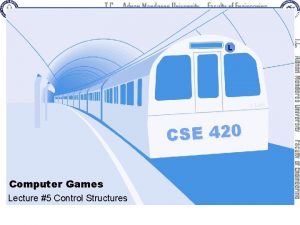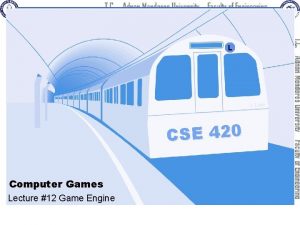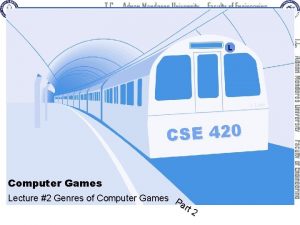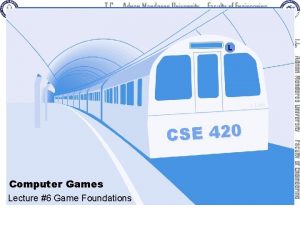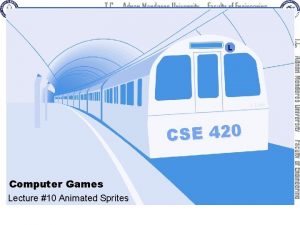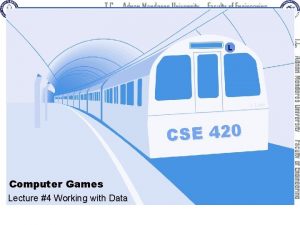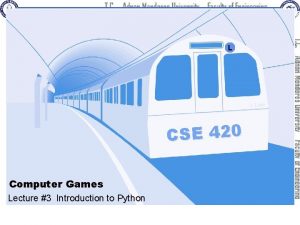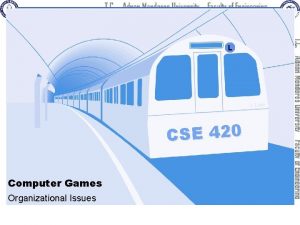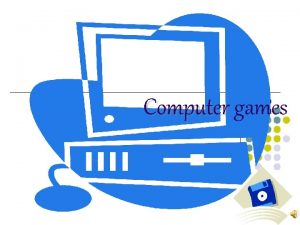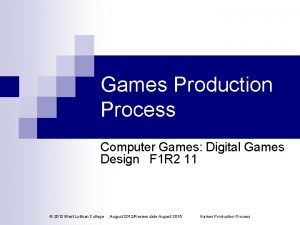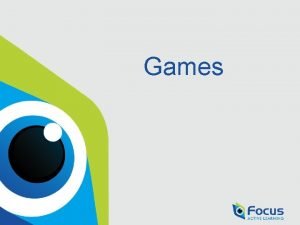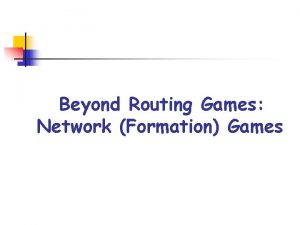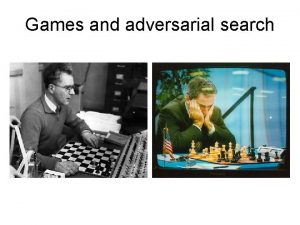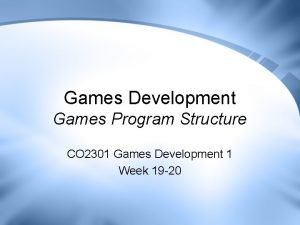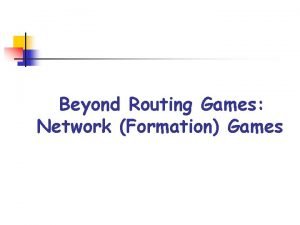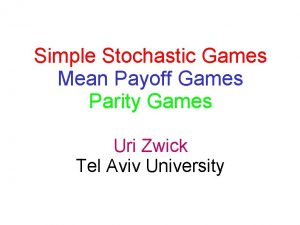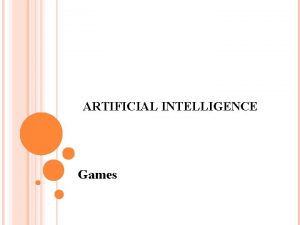L L Line CSE 420 Computer Games Lecture
























































- Slides: 56

L L Line CSE 420 Computer Games Lecture #9 Working Game

Objectives n n n n Planning a game Preparing a strategy for complex projects Building sprites to implement the plan Building an infinitely scrolling background Working with multiple sprite collisions Making a scorekeeping sprite Understanding state-transition diagrams Building a multi-state game Lecture #9 Working Game

Goal: Build a Complete Game n n n Instruction screen Player avatar Opponents and goals Scrolling background Scorekeeping See mail. Pilot. py. Lecture #9 Working Game

Game Design Essentials n n n An environment Goals Obstacles Appropriate difficulty for user Art and music assets Reasonable scope of programming challenge Lecture #9 Working Game

Game Sketch n n n n Sketch the user's experience on paper. Label everything. Describe each object's key features. Describe motion and boundary behavior for each object. Plan for sound effects. Show depth/overlaps. Describe scorekeeping/game end. Lecture #9 Working Game

A Sample Game Sketch Lecture #9 Working Game

Stepwise Refinement n n n Remember, this is a complex program. You can't expect to finish it in one step. Identify milestones to work towards. Lecture #9 Working Game

Milestones for Mail Pilot n n n n Basic plane sprite (mp. Plane. py) Island sprite (mp. Island. py) Cloud sprite (mp. Cloud. py) Collisions and sound effects (mp. Collide. py) Scrolling ocean background (mp. Ocean. py) Multiple clouds (mp. Multi. Clouds. py) Scorekeeping (mp. Score. py) Intro screen (mp. Intro. py) Lecture #9 Working Game

Building the Basic Airplane Sprite n n n Standard sprite Image from spritelib Follows mouse's x value class Plane(pygame. sprite. Sprite): def __init__(self): pygame. sprite. Sprite. __init__(self) self. image = pygame. image. load("plane. gif") self. rect = self. image. get_rect() def update(self): mousex, mousey = pygame. mouse. get_pos() self. rect. center = (mousex, 430) Lecture #9 Working Game

Testing the Plane Sprite n See mp. Plane. py. n Create an instance of Plane. Put it in the all. Sprites group. n plane = Plane() all. Sprites = pygame. sprite. Group(plane) n Update the all. Sprites group. all. Sprites. clear(screen, background) all. Sprites. update() all. Sprites. draw(screen) pygame. display. flip() Lecture #9 Working Game

Adding an Island n See mp. Island. py. n Define the island sprite. The island moves down. n q q n dx = 0 dy = 5 It resets on reaching the bottom of the screen. Lecture #9 Working Game

Island Sprite Code class Island(pygame. sprite. Sprite): def __init__(self): pygame. sprite. Sprite. __init__(self) self. image = pygame. image. load("island. gif") self. rect = self. image. get_rect() self. reset() self. dy = 5 def update(self): self. rect. centery += self. dy if self. rect. top > screen. get_height(): self. reset() def reset(self): self. rect. top = 0 self. rect. centerx = random. randrange(0, screen. get_width()) Lecture #9 Working Game

Incorporating the Island n all. Sprites now includes both the island plane = Plane() island = Island() all. Sprites = pygame. sprite. Group(island, plane) n Use all. Sprites for screen updates. all. Sprites. clear(screen, background) all. Sprites. update() all. Sprites. draw(screen) pygame. display. flip() Lecture #9 Working Game

The Island Illusion n n Add transparency. Crop close. Small targets are harder to hit. Move down to give the illusion the plane is moving up. Randomize to give the illusion of multiple islands. Lecture #9 Working Game

Adding a Cloud n n n See mp. Cloud. py. Add one cloud before using multiple clouds. A cloud moves somewhat like the island. Vertical and horizontal speed should be random within specific limits. The cloud resets randomly when it leaves the bottom of the screen. Lecture #9 Working Game

Cloud Sprite Code class Cloud(pygame. sprite. Sprite): def __init__(self): pygame. sprite. Sprite. __init__(self) self. image = pygame. image. load("Cloud. gif") self. image = self. image. convert() self. rect = self. image. get_rect() self. reset() def update(self): self. rect. centerx += self. dx self. rect. centery += self. dy if self. rect. top > screen. get_height(): self. reset() def reset(self): self. rect. bottom = 0 self. rect. centerx = random. randrange(0, screen. get_width()) self. dy = random. randrange(5, 10) self. dx = random. randrange(-2, 2) Lecture #9 Working Game

Using random. randrange() n n n The randrange() function allows you to pick random integers within a certain range. This is useful to make the cloud's side-to-side motion vary between -2 and 2. I also used it to vary vertical motion within the range 5 and 10. Lecture #9 Working Game

Displaying the Cloud n Keep adding new sprites to all. Sprites. plane = Plane() island = Island() cloud = Cloud() all. Sprites = pygame. sprite. Group(island, plane, cloud) n If you start having overlap problems, use pygame. sprite. Ordered. Update() rather than pygame. sprite. Group(). Lecture #9 Working Game

Adding Sound and Collisions n n Collision detection is critical to game play. Sound effects are often linked with collisions. They provide a natural test for collisions. Collisions and sound are often built together. Lecture #9 Working Game

Sound Effects Strategy n n Sound objects will be created for each sound indicated on the plan. Each sound object will be stored as an attribute of the Plane object (because all sound objects are somewhat related to the plane). Collisions will cause sounds to be played. See mp. Collision. py. Lecture #9 Working Game

Creating the Sound Objects n The following code is in the Plane init method. if not pygame. mixer: print "problem with sound" else: pygame. mixer. init() self. snd. Yay = pygame. mixer. Sound("yay. ogg") self. snd. Thunder = pygame. mixer. Sound("thunder. ogg") self. snd. Engine = pygame. mixer. Sound("engine. ogg") self. snd. Engine. play(-1) n n n Check for mixer. Initialize, if needed. Load sounds. Lecture #9 Working Game

Sound Effects Notes n n n See Appendix D on the Web site for details on creating sounds with Audacity. The engine sound is designed to loop. Use -1 as the loop parameter to make sound loop indefinitely. You may have to adjust volume to make sure background sounds aren’t too loud. Don't forget to turn sound off at end of the game. Lecture #9 Working Game

Checking for Collisions n Code occurs right after event checking in the main loop. #check collisions if plane. rect. colliderect(island. rect): plane. snd. Yay. play() island. reset() if plane. rect. colliderect(cloud. rect): plane. snd. Thunder. play() cloud. reset() n n Use colliderect() to check for collisions. Reset the sprite and play sound. Lecture #9 Working Game

Why Reset the Sprites? n n n If two sprites collide, you need to move one immediately. Otherwise, they’ll continue to collide, causing a series of events. The island cloud objects both have a reset() method, making them easy to move away from the plane. Lecture #9 Working Game

Building a Scrolling Background n n n Arcade games frequently feature an endless landscape. You can create the illusion of an endless seascape with a carefully constructed image. Use some image trickery to fool the user into thinking the image never resets. Lecture #9 Working Game

How Scrolling Backgrounds Work n n The background image is actually a sprite. It's three times taller than the screen. The top and bottom parts of the image are identical. The image scrolls repeatedly, swapping the top for the bottom when it reaches the edge. Lecture #9 Working Game

The Background Image Lecture #9 Working Game

Building the Background Sprite n See mp. Ocean. py. class Ocean(pygame. sprite. Sprite): def __init__(self): pygame. sprite. Sprite. __init__(self) self. image = pygame. image. load("ocean. gif") self. image = self. image. convert() self. rect = self. image. get_rect() self. dy = 5 self. reset() def update(self): self. rect. bottom += self. dy if self. rect. top >= 0: self. reset() def reset(self): self. rect. bottom = screen. get_height() Lecture #9 Working Game

Changes to Screen Refresh n n n The background sprite is larger than the playing surface. The background will always cover the screen. There's no need to call the sprite group update() method! #all. Sprites. clear(screen, background) all. Sprites. update() all. Sprites. draw(screen) Lecture #9 Working Game

Using Multiple Clouds n n n All the basic objects are done. Adding more clouds makes the game more challenging. The code for the clouds is done. Simply add code to control multiple clouds. See mp. Clouds. py. Lecture #9 Working Game

Creating Several Clouds n Create multiple cloud instances. cloud 1 = Cloud() cloud 2 = Cloud() cloud 3 = Cloud() n Put the clouds in their own group. friend. Sprites = pygame. sprite. Group(ocean, island, plane) cloud. Sprites = pygame. sprite. Group(cloud 1, cloud 2, cloud 3) Lecture #9 Working Game

Multiple Cloud Collisions n Modify the collision routine to use spritecollide(). hit. Clouds = pygame. spritecollide(plane, cloud. Sprites, False) if hit. Clouds: plane. snd. Thunder. play() for the. Cloud in hit. Clouds: the. Cloud. reset() n spritecollide returns a list of hit sprites or the value False. Lecture #9 Working Game

Analyzing the List of Hit Clouds n If the hit. Clouds list isn’t empty: q q q Play the thunder sound. Step through the hit. Clouds list. Reset any clouds that were hit. if hit. Clouds: plane. snd. Thunder. play() for the. Cloud in hit. Clouds: the. Cloud. reset() Lecture #9 Working Game

Screen Refresh Modifications n n n Now there are two sprite groups. Each group needs to be updated and drawn. There's still no need for clear() because the screen background is always hidden by the ocean sprite. friend. Sprites. update() cloud. Sprites. update() friend. Sprites. draw(screen) cloud. Sprites. draw(screen) pygame. display. flip() Lecture #9 Working Game

Adding a Scorekeeping Mechanism n n n The game play is basically done. The user needs feedback on progress. At a minimum, count how many times the player has hit each type of target. This will usually relate to the game-ending condition. See mp. Score. py. Lecture #9 Working Game

Managing the Score n The score requires two numeric variables: q q n self. planes counts how many planes (user lives) remain. self. score counts how many clouds the player has hit. Both variables are stored as attributes of the Scoreboard class. Lecture #9 Working Game

Building the Scoreboard Class n The scoreboard is a new sprite with scorekeeping text rendered on it. class Scoreboard(pygame. sprite. Sprite): def __init__(self): pygame. sprite. Sprite. __init__(self) self. lives = 5 self. score = 0 self. font = pygame. font. Sys. Font("None", 50) def update(self): self. text = "planes: %d, score: %d" % (self. lives, self. score) self. image = self. font. render(self. text, 1, (255, 0)) self. rect = self. image. get_rect() Lecture #9 Working Game

Adding the Scoreboard Class to the Game n Build an instance of the scoreboard = Scoreboard() n Create its own sprite group so it appears above all other elements. score. Sprite = pygame. sprite. Group(scoreboard) n Modify screen-refresh code. friend. Sprites. update() cloud. Sprites. update() score. Sprite. update() friend. Sprites. draw(screen) cloud. Sprites. draw(screen) score. Sprite. draw(screen) Lecture #9 Working Game

Updating the Score n When the plane hits the island, add to the score. if plane. rect. colliderect(island. rect): plane. snd. Yay. play() island. reset() scoreboard. score += 100 n When the plane hits a cloud, subtract a life. hit. Clouds = pygame. spritecollide(plane, cloud. Sprites, False) if hit. Clouds: plane. snd. Thunder. play() scoreboard. lives -= 1 Lecture #9 Working Game

Manage the Game-Ending Condition n The game ends when lives gets to zero. For now, simply print "game over. " The actual end of game is handled in the next version of the program. if hit. Clouds: plane. snd. Thunder. play() scoreboard. lives -= 1 if scoreboard. lives <= 0: print "Game over!" scoreboard. lives = 5 scoreboard. score = 0 for the. Cloud in hit. Clouds: the. Cloud. reset() Lecture #9 Working Game

Adding an Introduction State n n Most games have more than one state. So far, you've written the game play state. Games often have states for introduction, instruction, and end of game. For simplicity, mail. Pilot will have only two states. Lecture #9 Working Game

Introducing State Transition Diagrams n n n State diagrams help programmers visualize the various states a system can have. They also indicate how to transition from one state to another. They can be useful for anticipating the flow of a program. Lecture #9 Working Game

The mail. Pilot State Transition Diagram Lecture #9 Working Game

Implementing State in pygame n n n The easiest way to manage game state is to think of each major state as a new IDEA framework. Intro and game states each have their own semi-independent animation loops. The main loop controls transition between the two states and exit from the entire system. Lecture #9 Working Game

Design of mp. Intro. py n n n Most of the code previously in main() is now in game(). instructions() is a new IDEA framework displaying the instructions, previous score, and animations. main() now controls access between game() and instructions(). Lecture #9 Working Game

Changes to game() n n All game code is moved to game(). Return the score back to the main function so it can be reported to instructions(). Lecture #9 Working Game

Building the instructions() Function n n Build instances of plane and ocean. Store them in a sprite group. plane = Plane() ocean = Ocean() all. Sprites = pygame. sprite. Group(ocean, plane) n Create a font. ins. Font = pygame. font. Sys. Font(None, 50) Lecture #9 Working Game

Preparing the Instructions n Store instructions in a tuple. instructions = ( "Mail Pilot. Last score: %d" % score , "Instructions: You are a mail pilot, ", "other instructions left out for brevity" ) n Create a label for each line of instructions. ins. Labels = [] for line in instructions: temp. Label = ins. Font. render(line, 1, (255, 0)) ins. Labels. append(temp. Label) Lecture #9 Working Game

Rendering the Instructions n n n The instructions aren't sprites. They'll need to be blitted onto the screen after updating and drawing the sprites. Use a loop to blit all labels. all. Sprites. update() all. Sprites. draw(screen) for i in range(len(ins. Labels)): screen. blit(ins. Labels[i], (50, 30*i)) pygame. display. flip() Lecture #9 Working Game

Event-Handling in instructions() n Although instructions() isn't the full-blown game, it still has some event handling. for event in pygame. event. get(): if event. type == pygame. QUIT: keep. Going = False done. Playing = True if event. type == pygame. MOUSEBUTTONDOWN: keep. Going = False done. Playing = False elif event. type == pygame. KEYDOWN: if event. key == pygame. K_ESCAPE: keep. Going = False done. Playing = True Lecture #9 Working Game

Data Flow through instructions() n n n instructions() expects a score parameter. It uses this parameter to display the current score. It sends a Boolean value, done. Playing. q q If the user wants to play again, done. Playing is False. If user is finished, done. Playing is True. Lecture #9 Working Game

Managing the New main() Function n First time through, set done. Playing to False and score to zero. def main(): done. Playing = False score = 0 while not done. Playing: done. Playing = instructions(score) if not done. Playing: score = game() n n Pass score to instructions(). If they want to play, run game(), then pass score to done. Playing. Lecture #9 Working Game

Discussion Questions n n n In a small group, create a game diagram for a familiar game (such as Asteroids or Pong). What is parallax scrolling? How could it be implemented? How can a state-transition diagram be used to describe a game you already know? Lecture #9 Working Game

Summary n You should now understand q q q q Planning a game and preparing a strategy for complex projects Building sprites to implement the plan Building an infinitely scrolling background Working with multiple sprite collisions Making a scorekeeping sprite Understanding state-transition diagrams Building a multi-state game Lecture #9 Working Game

Next Lecture Animated Sprites Lecture #9 Working Game

References n Andy Harris, “Game Programming, The L Line, The Express Line to Learning”; Wiley, 2007 Lecture #9 Working Game
 01:640:244 lecture notes - lecture 15: plat, idah, farad
01:640:244 lecture notes - lecture 15: plat, idah, farad How do they suppose that haymitch won the games?
How do they suppose that haymitch won the games? Outdoor games and indoor games
Outdoor games and indoor games Representative fraction
Representative fraction Computer security 161 cryptocurrency lecture
Computer security 161 cryptocurrency lecture Computer aided drug design lecture notes
Computer aided drug design lecture notes Computer architecture notes
Computer architecture notes Isa definition computer
Isa definition computer Mini metric olympics worksheets answers
Mini metric olympics worksheets answers Arras penitenciais
Arras penitenciais Major minor patch build
Major minor patch build 84 as a product of prime factors in index form
84 as a product of prime factors in index form Factor tree 90
Factor tree 90 Cartesian vector example
Cartesian vector example Doe order 420
Doe order 420 Envee 420
Envee 420 Rosenberger hpk
Rosenberger hpk Amg420
Amg420 S-420 class
S-420 class Index currency option notes
Index currency option notes Hardenable 420 f
Hardenable 420 f Thursday420
Thursday420 Electivemed
Electivemed Mis-420
Mis-420 420 internet marketing
420 internet marketing Enve 420
Enve 420 Enve 420
Enve 420 Enve 420
Enve 420 Enve420
Enve420 Motion to determine confidentiality of court records
Motion to determine confidentiality of court records Resolucion 420/2011
Resolucion 420/2011 420
420 420 marketing campaigns
420 marketing campaigns Measures of dispersion definition
Measures of dispersion definition Article 420
Article 420 420 position
420 position Zebra rw 420
Zebra rw 420 Erdas imagine
Erdas imagine Enve420
Enve420 Cpsc 420
Cpsc 420 420 ucas points
420 ucas points 420 pst
420 pst 742 in expanded form
742 in expanded form Nasvac
Nasvac Issues in operations management
Issues in operations management Sophie quigley
Sophie quigley Wheel and axle in human body
Wheel and axle in human body Csci 420
Csci 420 420 разделить на 60
420 разделить на 60 Plato computer
Plato computer Introduction of opinion essay
Introduction of opinion essay Media assets in games
Media assets in games Ulysses alfred lord tennyson analysis
Ulysses alfred lord tennyson analysis To daffodils by robert herrick شرح
To daffodils by robert herrick شرح Thou blind man's mark rhyme scheme
Thou blind man's mark rhyme scheme Write a poem of 14 lines
Write a poem of 14 lines Simile in the poem taj mahal
Simile in the poem taj mahal








